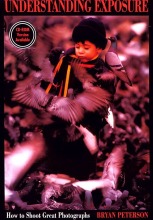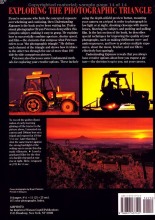Digital
101 Exposure Part 4
In
conjunction with the Nikon Talk Forum
at DP Review
It's
All in the Tones...
I
wish I had the time and the energy to spend years working on an exposure
system that will allow me to quickly make decisions about how to
properly expose and image. I have read many articles and took some from
here and some from there to finds what works for me.
First
I want you to do a test if you haven't already.
Take your digital camera and find an image with good range of
different light. Then take sample readings from different areas of the
image and take a photo and look at it. If you used a bright area of the
photo the darker areas will be totally black. If you use the dark areas
to base the exposure the light areas will be totally washed out. Now
look for a color in the image that is middle tone. Not dark or light but
right in between. Now base your exposure on this area of the image and
see what happens? Your dark areas are not to dark, your light areas are
not to light, and the middle tones are perfect.
Even
the metering system in your camera will try to make verything middle
tone. Since you may have as many as 30 stops of light from bright white
to pitch black you can see there is no way you can use either of these
extremes to base your exposure. So your camera's metering system tries
to average everything, to find that middle ground. For years cameras had
center weighted metering systems that always assumed the subject would
be in the middle of the image. Yeah right. Now most cameras have a
matrix system that will divide the image area into sections and average
these together to get the best exposure.
John
Gerlach a well known nature photographer from Michigan divides his
exposure into seven possibilities which range from snow to black and
assigns a minus or plus exposure compensation for each. He teaches his
students to be able to look at a subject and instantly make a decision.
Since he shoots slide film and sometimes needs 20 exposures of an image
for the stock houses he send his pictures to he must be able to look at
any situation and instantly make a decision on exposure. If you want to
learn more about exposure in a single day then you can learn in years.
I suggest you contact John and attend one of his seminars.
His
address follows:
John
Gerlach
PO Box 259
CHATHAM, MI 49816.
I
don't have to make decisions that quickly and at 57 not to sure I want
to but I have learned so much from John's information on exposures that
I wanted to pass his name on to you. I wish I could discuss many of his
ideas with you but you know that copyright thing. I do want to give you
information on how I base my exposures.
As
I look at any image I try to find the middle tone and I base my exposure
on that area first. With film I never knew if I was right until it was
developed. With digital you know right now. I will look for the middle
tone then if needed I take the recommended exposure and set it in the
manual mode. That way the camera can't change the reading. Sometimes I
zoom in the middle tone area to fill the frame then take my reading and
set it in manual.
What
if there is no middle tone? Simple I carry several 12-inch squares of
middle tone swatches of fabric in my bag. One each of; green, brown,
blue (actually a piece of faded blue jean) and gray. Fabric can be
folded and stuffed in a small place so it is easier to carry then a gray
card. Now if you use these middle tone samples they must be in the same
light as your subject or it won't work. You can also take a reading form
the dark areas and light areas and average the two.
At
some point you might say why don't you just use automatic.
I have had a camera in my hands for 42 years. Before metering
systems and when I had to set everything manual. I feel more comfortable
setting my own exposures. Plus auto exposure systems are accurate about
80% of the time. The other 20% needs some kind of adjustment. So with
automatic one in five pictures will not be exposed properly. Not good
enough for me. That and while I don't need deep technical explanations I
do need to know how to use my camera to the best of my ability.
So I use the manual side of the dial. I have more control in
manual and the camera can't change my settings. I got the power, I the
man.
Next
couple of days and I will post the last in this series. I
will discuss difficult exposure situations and how to make them simple.
I really appreciate the feed back and compliments. If I can help you
take an image that will last a lifetime then I have accomplished my
goal.
Troutman
Click
here to discuss this tutorial on the Nikon Talk Forum at DPReview...
<<
[ Back ]
|
For
further reading...
Take a look at "Understanding
Exposure"
by Bryan Peterson.
 |
 |
| Front
Cover |
Back
Cover |
"If
you're someone who finds the concept of exposure overwhelming
and confusing, then Understanding Exposure is the book you've
been waiting for. Professional photographer Bryan Peterson
demystifies this complex subject, making it easy to grasp."
(taken from the back cover)
This
144 page book also includes more than 100 side-by-side
comparison pictures.
Click
here for more details and to purchse
|
